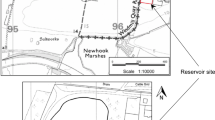Summary
The Lower Lias Clay at Blockley, 20 km due south of Stratford-upon-Avon, UK, is thought to be representative of this clay formation over much of the Severn Basin. As far as the mineralogy of the clay is concerned, illite is the dominant clay mineral, kaolinite being subsidiary, with quartz, calcite, pyrite and chlorite/vermiculite present in subsidiary or accessory amounts. Weathering changes the mineralogy, with illite being degraded and calcite and pyrite being removed. Furthermore free iron oxide coatings become important as a result of weathering, with the maximum concentrations being present in the highly weathered material.
The unweathered clay possesses a preferred orientation associated with turbostratic structures. At certain horizons microfolding and remoulding occurs in the unweathered clay and silty layers are displaced. Weathering has progressively destroyed the micro-structures present in the weathered clay horizons.
The fissures in the Lower Lias Clay occur in five uniplanar sets. In the unweathered clay the intensity is fairly constant but it increases in a narrow zone just below the weathered horizons. The number of curved fissures also increases at this depth. This intense fissuring continues into the lowest zone of weathered clay where weathering is confined to the fissure surfaces. Fissures become less apparent in the more weathered horizons as more and more degradation has taken place. However, new smaller fissure systems are developed in the weathered clay, as are desiccation cracks.
Engineering index properties and values of shear strength are given. Relationships between moisture content and strength, liquid limit and iron (Fe) content were observed, and a relationship between weathering zones and the shear strength-depth curve was established.
Similar content being viewed by others
References
AylmoreL. and QuirkJ.P. (1966) Domain or turbostratic structure of clays, Nature, 187, 1046–8.
ChandlerR.J. (1972) Lias Clay: weathering processes and their effect on shear strength, Geotechnique, 22, 403–31.
FookesP.G. (1965) Orientation of fissures in stiff overconsolidated clay of the Siwalik System, Geotechnique, 15, 195–200.
FookesP.G. and DennessB. (1969). Observational studies on fissure patterns in Cretaceous sediments of south east England, Geotechnique, 19, 453–77.
MorgensternN.R. and TchalenkoJ.S. (1967) Orientation of clay minerals by birefringence, Proceedings Royal Society, Series A, 300, 218–50.
SkemptonA.W., SchusterR.L. and PetleyD.J. (1969) Joints and fractures in the London Clay at Wraysbury and Edgeware. Geotechnique, 19, 205–17.
Author information
Authors and Affiliations
Rights and permissions
About this article
Cite this article
Coulthard, J.M., Bell, F.G. The engineering geology of the Lower Lias Clay at Blockley, Gloucestershire, UK. Geotech Geol Eng 11, 185–201 (1993). https://doi.org/10.1007/BF00531250
Received:
Issue Date:
DOI: https://doi.org/10.1007/BF00531250




